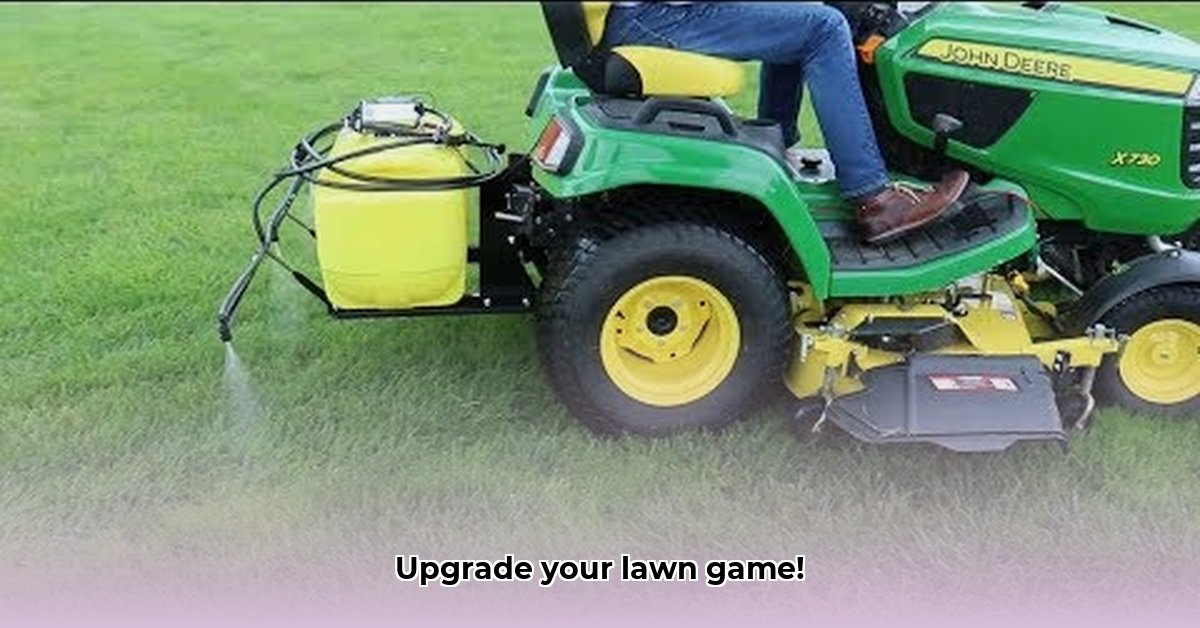
Getting Started: Choosing the Right Sprayer
Ready to transform your lawn care routine? A lawn tractor sprayer offers efficiency and ease, but choosing the right one is crucial. What size is your lawn? A small yard needs a smaller tank than a large property. What will you be spraying? Weed killer, fertilizer, or something else? Different nozzles create different spray patterns (e.g., fan-shaped for even coverage, focused for spot treatment). Consider these factors to ensure you select a sprayer that perfectly matches your lawn's size and your specific needs. Don't forget to check online reviews to compare different models and find one that fits your budget. For more information on lawn tractors, check out this helpful resource: John Deere Lawn Tractor.
Setting Up Your Lawn Sprayer: A Step-by-Step Guide
Attaching your sprayer to your lawn tractor is usually straightforward, but always consult the manufacturer's instructions. Safety is paramount; prioritize reading the safety guidelines for both your tractor and sprayer before you begin.
- Preparation: Gather all necessary tools and personal protective equipment (PPE), including gloves and eye protection. Carefully read all instructions before proceeding.
- Secure Mounting: Carefully attach the sprayer to your tractor using the supplied brackets. Double-check all connections to ensure a secure fit. A loose connection can lead to leaks and uneven application or spraying accidents.
- Filling the Tank: Fill the tank with the appropriate solution, following the manufacturer's instructions and safety precautions precisely. Accurate measurement is crucial to avoid over- or under-application. Use measuring tools provided and follow the mixture ratio instructions on the chemical label.
Calibrating Your Sprayer for Optimal Performance
Accurate calibration is vital for even coverage and prevents chemical waste. An improperly calibrated sprayer can lead to uneven treatment or significant product loss. This translates to wasted money and potentially ineffective treatments. What percentage of your lawn care budget is wasted due to inconsistent application?
- Test Area: Mark a 1000-square-foot test area on your lawn.
- Water Test: Fill the tank with only water and spray the marked area.
- Measurement: Measure the amount of water used.
- Adjustment: Adjust your sprayer's settings until you achieve the application rate recommended on the product label for your specific solution. Small adjustments can make a big difference.
Application Techniques for Even Coverage
Even application is key to a healthy lawn. Overlapping passes ensures complete coverage but going too fast can lead to uneven spraying and wasted product. What is the ideal speed for even application with your specific equipment and lawn conditions?
- Consistent Speed: Maintain a slow and steady speed throughout the application process.
- Overlap: Overlap each pass slightly to prevent gaps in coverage.
- Wind Conditions: Avoid spraying on windy days, as this may result in drift and uneven application.
- Optimal Conditions: Spray on a calm day with moderate temperatures for optimal results. Avoid spraying in direct sunlight or extreme heat, as this can affect product effectiveness.
Maintenance and Storage: Extending Your Sprayer's Lifespan
Proper maintenance extends your sprayer's life and ensures consistent performance. What are the long-term cost savings associated with proper sprayer maintenance?
- Cleaning: After each use, thoroughly rinse the tank and sprayer with clean water to prevent clogs and corrosion.
- Storage: Store the sprayer in a cool, dry place, away from children and pets. Protect it from the elements to maintain its functionality.
Troubleshooting Common Issues
- Clogged Nozzles: Check for debris; clean with a thin pin or small brush. Refer to your user manual for specific instructions.
- Low Pressure: Ensure the tank is properly filled, and all connections are secure.
- Uneven Spray: Recalibrate the sprayer and check for nozzle clogs. The nozzle setting and tank pressure may also be contributing factors.
Safety Precautions: Handling Chemicals Responsibly
Always prioritize safety. What is the most important safety precaution when using a lawn tractor sprayer? Dr. Emily Carter, PhD, Extension Specialist in Horticulture, University of California, Davis, emphasizes: "Always wear appropriate personal protective equipment (PPE), including gloves, eye protection, and long sleeves, when handling chemicals. Carefully follow all safety warnings on the product labels and your sprayer’s instructions."
- PPE: Wear appropriate personal protective equipment (PPE).
- Safe Storage: Store chemicals safely, away from children and pets.
- Mixing: Never mix chemicals without checking compatibility on the labels.
Sustainable Lawn Care: Minimizing Chemical Use
Precision spraying significantly reduces chemical use by targeting applications, leading to environmental benefits and cost savings. Integrated Pest Management (IPM) further minimizes chemical reliance, prioritizing preventative measures. Both precision spraying and IPM are important aspects of sustainable lawn care.
Conclusion: Achieving a Lush, Healthy Lawn
Using a lawn tractor sprayer simplifies lawn care, providing a more efficient and less strenuous way to maintain your lawn. Remember: proper setup, calibration, application techniques, maintenance, and safety precautions are crucial for achieving optimal results and a healthier, more beautiful lawn.